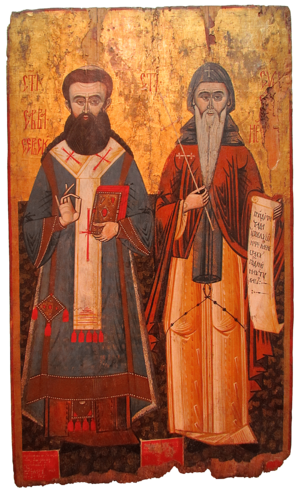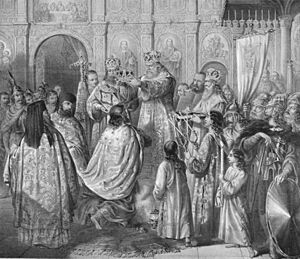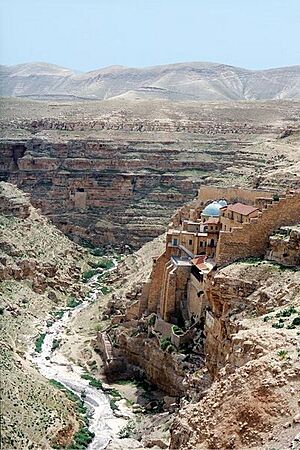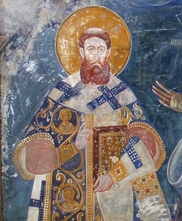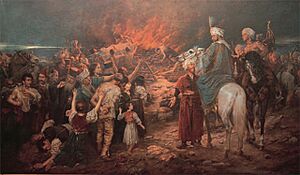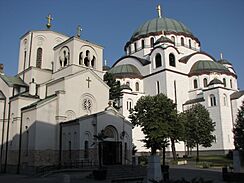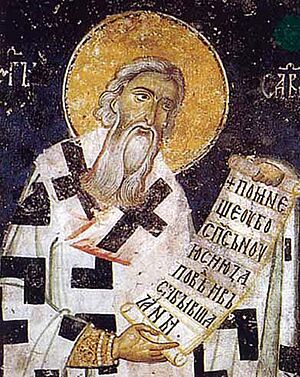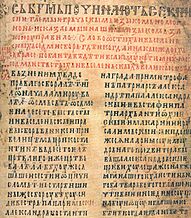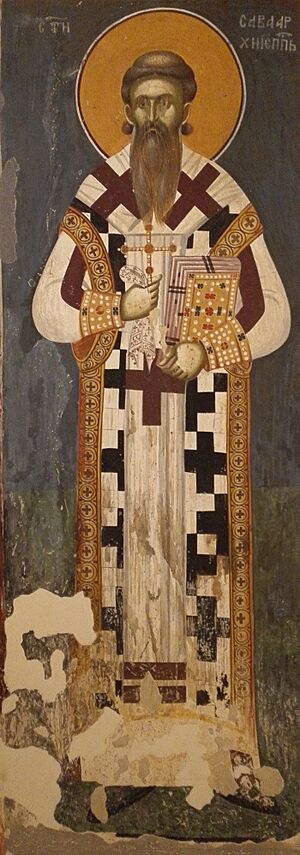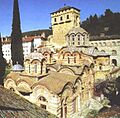Saint Sava facts for kids
Quick facts for kids SaintSava Archbishop of Serbia The Illuminator |
|
|---|---|
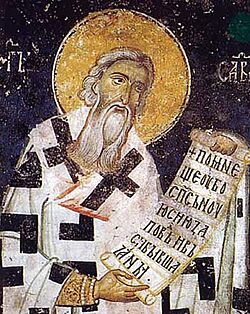
Fresco detail of Saint Sava in Serbian Orthodox Patriarchate of Peć monastery, Serbia
|
|
| Prince, Archbishop, Confessor, Equal to the Apostles |
|
| Born | Rastko Nemanjić 1169 or 1174 Gradina, Zeta |
| Died | 27 January 1236 (61–62 or 66–67) Tarnovo, Bulgarian Empire |
| Venerated in | Eastern Orthodox Church Catholic Church |
| Major shrine | Church of Saint Sava, Belgrade |
| Feast | January 27 [O.S. January 14] |
| Attributes | Ktetor, teacher, theologian, legislator, diplomat, protector of the poor, writer |
| Patronage | Serbia, Serbs, Serbian schools |
Saint Sava (born Rastko Nemanjić) was a Serbian prince who became an Orthodox monk. He is known as the Enlightener because he helped shape the Serbian Church and nation. Sava was the first Archbishop of the independent Serbian Church. He also helped create Serbian law and was a skilled diplomat.
Sava was the youngest son of Serbian Grand Prince Stefan Nemanja, who founded the Nemanjić dynasty. For a short time, Sava ruled a region called Zachlumia. But he soon left to become a monk on Mount Athos. There, he founded the Hilandar monastery, which became a very important place for Serbian culture and religion.
In 1219, the Church leaders in Nicea recognized him as the first Serbian Archbishop. That same year, he wrote Serbia's oldest known constitution, the Zakonopravilo. This document helped Serbia gain full religious and political independence. Saint Sava is seen as a key figure in Serbian history and the founder of Serbian medieval literature.
He is honored by the Eastern Orthodox Church on January 27 (or January 14 by the old calendar). Many artworks show his life. He is the patron saint of Serbia, Serbs, and Serbian education. The huge Church of Saint Sava in Belgrade is dedicated to him. It stands where his remains were burned in 1594 during an uprising.
Contents
Biography of Saint Sava
Early Life and Becoming a Monk
Rastko Nemanjić was born in 1169 or 1174 in Gradina. He was the youngest son of Grand Prince Stefan Nemanja and Queen Ana. His parents loved him very much because he was born after they had not had children for a while. Rastko and his brothers, Vukan and Stefan, received a good education. They learned a lot from the Byzantine traditions, which were very important in Serbia.
Rastko was a serious and quiet young man. When he was young, around 1190, he became the Prince of Hum. This was a real job, not just a title. He had his own court and officials. He was known for being kind and caring for the poor. But Rastko was not interested in fame or power. After only two years, in 1192, he left Hum for Mount Athos. He wanted to become a monk.
Life on Mount Athos
When Rastko arrived at Mount Athos, he became a monk and took the name Sava. He first stayed at a Russian monastery, then moved to a Greek monastery called Vatopedi. He spent seven years there, learning a lot about theology and church rules. His father tried to convince him to come back to Serbia. But Sava told him to join him in the monastic life instead. His time on Mount Athos greatly influenced how he would later organize church life in Serbia.
His father, Stefan Nemanja, listened to Sava's advice. In 1196, Nemanja gave up his throne to his middle son, Stefan. The next day, Nemanja and his wife Ana also became monks. Nemanja took the name Simeon. He later joined Sava on Mount Athos in 1197. Sava and the monks were very happy to see him. Nemanja had given a lot of money to the monasteries.
Sava visited the Byzantine Emperor Alexios III Angelos in Constantinople. He asked the Emperor for permission to rebuild a neglected monastery called Hilandar. The Emperor agreed, and Hilandar became a home for Serb monks on Mount Athos. Sava and his father worked together to restore the monastery. Grand Prince Stefan also sent money and supplies.
Sava wrote a special set of rules, called a typikon, for Hilandar. He also built a small hermitage for monks who wanted to live alone and pray. In 1199, his father Simeon passed away. In 1204, Sava became an archimandrite, a high rank for a monk.
After some problems on Mount Athos, Sava returned to Serbia in 1205 or 1206. He brought his father's remains back to the Studenica monastery. He also helped his brothers, Stefan and Vukan, stop their fighting. Sava's return and his efforts to make his father a saint helped bring peace to the country.
Enlightening the Serbian People
Sava had spent 14 years on Mount Athos and gained great knowledge. When he returned to Serbia, he became the head of the Studenica monastery. He worked hard to teach the Serbian people about Christian laws and traditions. He focused on Christian values like kindness and mercy. He also worked on organizing the Serbian Church.
Sava used the difficult situation of the Byzantine Empire to his advantage. The empire was in chaos after the siege of Constantinople (1204). This allowed Sava to make Studenica monastery more independent. This was a step towards the Serbian Church becoming fully independent.
In 1217, Sava left Studenica and went back to Mount Athos. This happened around the time his brother Stefan was crowned King by Rome. Some historians believe Sava disagreed with Stefan's close ties to Rome. However, Sava and Stefan remained on good terms. It is also thought that Sava's trip to Athos was part of his plan to gain independence for the Serbian Church. He carefully prepared for his departure, appointing a new head for Studenica.
Making the Serbian Church Independent
For Serbia to be truly independent, its church also needed to be independent. On August 15, 1219, Sava was made the first Archbishop of the independent Serbian Church. This happened in Nicaea, where the Patriarch of Constantinople was living at the time. Sava was given the title "Archbishop of Serbian and coastal lands." This meant that Serbian archbishops could now be chosen by their own bishops. This was a huge step for Serbia's independence.
After this, Archbishop Sava returned to Mount Athos and then to Thessaloniki. He spent time there copying important law books for his church.
When he came back to Serbia, he worked on organizing the Serbian Church. He chose good and wise monks to become bishops. He gave them law books and sent them to different parts of Serbia. He established many new bishoprics (church regions). The main seat of the Church was at the Monastery of Žiča.
In the same year, Sava published the Zakonopravilo (also called "St. Sava's Nomocanon"). This was the first constitution of Serbia. With this, Serbs gained both political and religious independence. Sava's work gave the Serbian Church a strong national identity. He made Orthodoxy the official state religion of Serbia. He also worked to improve the general cultural level of the people. Sava helped shape the Serbian state both spiritually and intellectually.
First Journey to the Holy Land
In 1229, after his nephew Radoslav became king, Sava traveled to Palestine. He visited many holy places and gave valuable gifts to them. The Patriarch of Jerusalem welcomed him warmly. Sava bought two monasteries in the Holy Land for Serbian monks.
On his way back, he visited Nicaea and then Mount Athos. He then returned to Serbia. While visiting Mar Saba, he received a special gift: the Trojeručica icon (the "Three-handed Theotokos") and the staff of Sabbas the Sanctified. He brought these precious items to Hilandar. After a short stay in Studenica, Sava traveled around Serbia for four years. He taught people about Christian beliefs and monastic life.
Second Journey and Passing Away
In 1234, King Radoslav was replaced by his brother Vladislav. Before his second trip to the Holy Land, Archbishop Sava chose his loyal student Arsenije Sremac to be his successor. Sava knew Arsenije was a good and wise choice for the future of the Serbian Church.
Sava started his journey from Budva, then traveled through Italy to Acre. He faced challenges, including a pirate attack at sea, but he arrived safely. In Acre, he stayed at his monastery dedicated to St. George. He then went to Jerusalem and visited the Monastery of St. John the Apostle, which he had bought. Sava stayed in Jerusalem for a long time and was welcomed by Patriarch Athanasius. He also visited Alexandria and the Sinai.
After visiting holy places in Egypt, he returned to Jerusalem. From there, he traveled through various lands and eventually arrived in Constantinople. Sava then decided to visit the Bulgarian capital, Tarnovo. He was warmly welcomed by the Bulgarian Emperor Ivan Asen II.
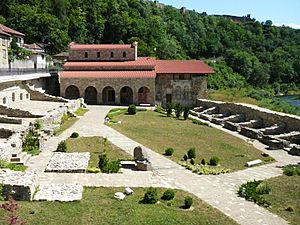
Sava gave many rich gifts to the churches and monasteries in Tarnovo. After much work and many long journeys, Sava became very tired and sick. He sent some of his companions back to Serbia with gifts and blessings for his people. He passed away between Saturday and Sunday, most likely on January 27, 1235.
Sava was buried with respect at the Holy Forty Martyrs Church. King Vladislav wanted Sava's body to be returned to Serbia. After many requests, Emperor Ivan Asen II finally agreed. With great honors, Saint Sava's relics were moved from Tarnovo to the Mileševa monastery in Serbia on May 19, 1237. Sava was made a saint, and his relics were believed to have miraculous powers. His memory remained strong through the Middle Ages and during Ottoman rule.
Saint Sava's Legacy
Saint Sava is seen as the protector of the Serb people. He is honored as a protector of churches, families, schools, and craftspeople. His feast day is celebrated by Greeks, Bulgarians, Romanians, and Russians too. Many places and stories still speak of his importance. Saint Sava is considered the father of Serbian education and literature. He wrote the Life of St. Simeon, which was the first Serbian biography of a saint. He is often called "Father" and "Enlightener."
The Serbian people created many songs, stories, and legends about Saint Sava. They admired his life, work, kindness, fairness, and wisdom. His relics became a symbol of freedom. In 1840, Saint Sava's feast day was chosen to celebrate Education every year. It was a school holiday until 1945. In 1990, it was brought back as a school holiday.
The Serbian Orthodox Church celebrates Saint Sava on January 27 (or January 14 by the old calendar).
Burning of Relics
In 1594, Serbs in Banat rebelled against the Ottomans. They used pictures of Saint Sava on their war flags. In response, the Ottoman Grand Vizier ordered Sava's relics to be brought from Mileševa to Belgrade. On April 27, he had them burned on the Vračar plateau. The Ottomans wanted to crush the Serbs' desire for freedom. However, this event only made the rebellion stronger. It is believed that his left hand was saved and is now kept at Mileševa.
The Church of Saint Sava was built near the place where his relics were burned. Its construction began in the 1930s and was finished in 2004. It is one of the largest churches in the world.
Churches Dedicated to Saint Sava
Many churches are dedicated to Saint Sava. As early as the 14th century, Serbian Archbishop Nikodim I dedicated a church to him. There are churches dedicated to him throughout Serbia, Bosnia and Herzegovina, Croatia, and Montenegro. There are also churches in Serb communities around the world.
Visual Arts
Almost every Serbian church has a picture of Saint Sava. He is often shown as a main priest or with his father, Saint Simeon. Famous paintings of him are in monasteries like Studenica, Mileševa, Peć, and Hilandar. He is also shown with the Nemanjić dynasty in places like Dečani.
There are many icons (religious paintings) of Saint Sava. Some show him with Saint Simeon. These icons are found in museums and monasteries. His image is also on old Serbian printed books and metal church items.
Literature
Many Serbian poets have written poems about Saint Sava. These include famous writers like Jovan Jovanović Zmaj, Vojislav Ilić, Aleksa Šantić, and Desanka Maksimović. Their poems celebrate his life and importance.
Saint Sava's Writings
Sava's earliest writings were about how monks should live. These include the Karyes Typikon and Hilandar Typikon. These were like rulebooks for monasteries. They show Sava's language and style.
- Karyes Typikon: Written in 1199 for the Karyes cell. It helped monks live a solitary life.
- Hilandar Typikon: Written in 1199 for Hilandar monastery. Sava adapted Greek rules to fit Hilandar's needs. This became a guide for other Serbian monasteries.
Sava also organized the laws for the Serbian Church. He created a code called the Nomocanon or Krmčija. This book combined state laws and church rules. It made Serbia a country with strong laws. Sava started this project, and different people helped with the translation. This book was very important for Serbian law.
- Zakonopravilo (or Krmčija): Most likely created in Thessaloniki in 1220. This book was key for organizing the new, independent Serbian Church. It was a mix of civil (state) law and religious rules. It became the main source of law in medieval Serbia.
Sava also wrote a personal letter from Jerusalem to his student Spiridon in Studenica. This is the first known letter in old Serbian literature. It shows Sava's feelings and care for his homeland.
His most important literary work is the Hagiography of St. Simeon.
- Hagiography of St. Simeon: Written in 1208. This book tells the story of his father, Stefan Nemanja (Saint Simeon). It focuses on Simeon's life as a monk and how he gave up his throne for a spiritual life. Sava wrote it in a direct and simple way.
Very few of Saint Sava's original writings have survived. Saint Sava is considered the founder of independent medieval Serbian literature.
Saint Sava as a Founder and Donor
Sava founded and rebuilt many churches and monasteries. Even before his father arrived at Vatopedi, he founded three chapels. He was seen as a great donor to many monasteries on Mount Athos, including Iviron, Great Lavra, and Hilandar. Hilandar was the most important, which he founded with his father in 1198.
When he returned to Serbia in 1206, Sava continued his work. He helped paint the Mother of God Church in Studenica. His most important building project was the Home of the Holy Saviour, called Žiča. This became the first seat of the Serbian Archbishopric. He also helped build the Church of the Holy Apostles in Peć and the Mileševa monastery. In Palestine, he founded the Monastery of St. John the Apostle for Serb pilgrims. Sava gave a lot of gold to monasteries in Palestine, Thessaloniki, and Mount Athos. His work as a founder and donor showed his deep faith.
- Hilandar monastery on Mount Athos
- Karyes monastery cell (see: Karyes Typicon)
- Church of John the Apostle in Jerusalem
And many other churches across Serbia, as well.
|
|
Images for kids
See also
- Serbian Orthodox Church
- Serbian Saints
- Eastern Orthodox Saints
- Order of St. Sava
- Only Unity Saves the Serbs
- John the Deacon
| Religious titles | ||
|---|---|---|
| First Founding of
Serbian Church |
Archbishop of Serbs December 6, 1219 – 1233 |
Succeeded by Arsenije |
| Royal titles | ||
| Preceded by Miroslav |
Prince of Hum under Stefan Nemanja 1190 – 1192 |
Succeeded by Miroslav or Toljen |
Annotations


